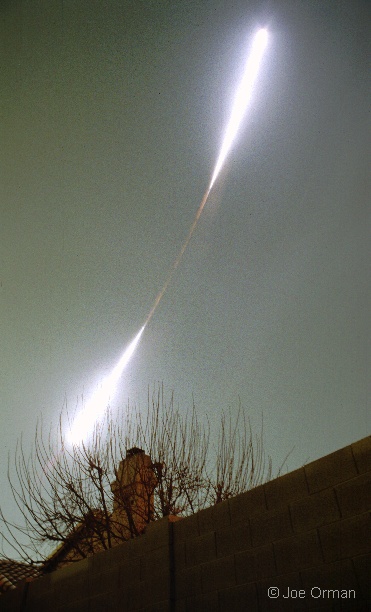Credit & Copyright: Joe Orman
Explanation:
Tonight, Friday the 13th, October's big, bright, beautiful
full Moon
will be in the sky, rising as the sun sets.
A time exposure of this evening's full Moon would show a brilliant
circular arc or Moon trail tracing its celestial path.
In fact, this single,
four hour long exposure from the
evening of January 20 shows a full Moon trailing
through hazy
skies above Phoenix, Arizona, USA.
Of course, the picture also shows something you won't see
tonight -- a total
lunar eclipse.
A lunar eclipse is caused when
the full moon enters
Earth's
shadow and
as the eclipsed Moon's light grows steadily
fainter, the Moon trail becomes narrow and dim.
The total eclipse phase, when the Moon passes completely within
Earth's shadow,
occurs near the middle of this Moon
trail arc.
But even during totality, the Moon trail is visible and noticeably red.
Normally illuminated by sunlight which falls directly on
its surface, during a total
lunar eclipse the Moon is still illuminated
by sunlight filtered and refracted through Earth's atmosphere.
The refracted light lends the
eclipsed Moon a dim
and reddish appearance.
1999 2000 2001 2002 2003 2004 2005 2006 2007 2008 2009 2010 2011 2012 2013 2014 2015 2016 2017 2018 2019 2020 2021 2022 2023 2024 2025 |
Yanvar' Fevral' Mart Aprel' Mai Iyun' Iyul' Avgust Sentyabr' Oktyabr' Noyabr' Dekabr' |
NASA Web Site Statements, Warnings, and Disclaimers
NASA Official: Jay Norris. Specific rights apply.
A service of: LHEA at NASA / GSFC
& Michigan Tech. U.
|
Publikacii s klyuchevymi slovami:
lunnoe zatmenie - Moon - eclipse - lunar eclipse - Luna
Publikacii so slovami: lunnoe zatmenie - Moon - eclipse - lunar eclipse - Luna | |
Sm. takzhe:
Vse publikacii na tu zhe temu >> | |
